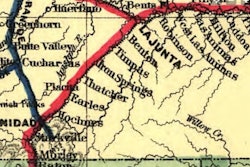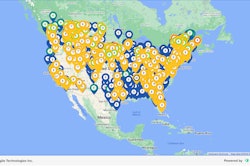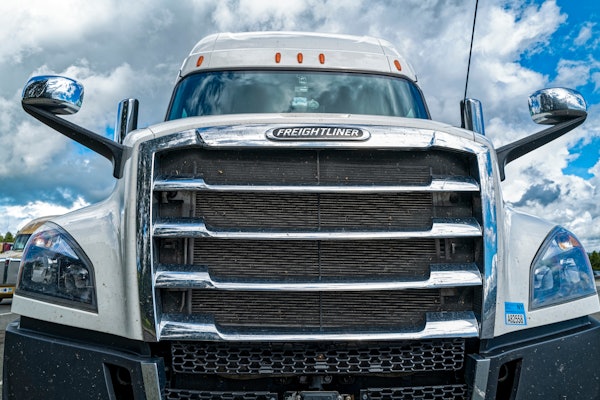A looming tidal wave of commercial truck electrification has prompted fleet managers across the country to take crash courses in how their terminals get their power.
There are three aspects to accessing electric power: generation, transmission and distribution. Previously, those three things did little more than keep the lights on at a trucking fleet, but a future where they are required to keep trucks running is not too far on the horizon.
Energy and electric transportation consultant Mike Rowand noted the need for collaboration between trucking and electric utilities – “two industries that really haven’t had to talk much in the past.”
Rowand served as moderator Tuesday at the American Trucking Associations Technology Maintenance Council’s Annual Meeting & Transportation Technology Exhibition in New Orleans for a discussion titled Everything you Wanted to Know About Your Electric Power Provider but Were Afraid to Ask.
When commercial battery electric trucks land on the grid, Rowand said it won’t be a soft landing. He said 50 Class 8 semis require the same power that the Empire State building does, and that makes communication between the fleet and the power provider critical.
“You can’t just build the Empire State building and say, ‘Okay, I’m ready for service,” he said, especially if your fleet is serviced by a small cooperative or municipal utility. Roughly, 56% of the U.S. is covered by electric cooperatives, many in rural areas.
"I would reach out to the utility before the [truck] dealership," added Jim Musilek, vice president of innovation and business development at North Carolina Electric Cooperatives in Raleigh, North Carolina.
Every 20 years, beginning in the back half of last century, the grid expanded at a rate fast enough to support 100% electrification transportation, but as utilities shuttered politically unpopular coal-fired plants to construct cleaner and greener options like renewables and natural gas, Rowand said capacity capabilities became less certain. Coal currently makes up 16% of electric power generation. Most – 42% – comes from natural gas.
The push to produce greener electric power isn't going away, added Musilek, noting his group of 26 electric cooperatives have a net zero emission target of 2050.
Increases in severe weather events – forecast to continue increasing – pose a threat to the grid, said Scott Barios, manager of Entergy's eMobility portfolio, meaning utilities have to balance expansion with protecting existing capacity.
Many utilities are developing a rate structure to stimulate electrification. However, rate variability from utility to utility makes calculating a universal total cost of ownership difficult, Musilek said. And that, too, is likely to include a change in how utilities see trucking companies as a customer.
"If you're a fleet depot, you're probably not a managed account ... but you soon will be," Barios said.
Orlando Utilities serves 270,000 electric customers and is the 14th largest municipal power provider in the country. Peter Westlake, manager of capital projects, said OUC kicked off a reimagined electrification plan in 2020 to increase EV density by 35,000 – a 5% penetration by 2025.
"That 35,000 vehicles represents approximately $16 million additional gross revenue for the company," he said, adding the utility has committed $45 million over the next decade to install up to eight charging hubs, erect an education center and install an electric bus and commercial fleet infrastructure, among other things. Two commercial hubs are in the concept stage, Westlake said.
"These types of hubs are going to be what really starts the ball rolling," he said. "If I can get two of them in strategic places in Orlando, I can actually start to covert [fleets] who are worried about the amount of time that it takes to convert their operation."
David Treichler, director of strategy and technology for Texas-based Oncor electric delivery, noted the Dallas-Fort Worth area is home to four pockets of high concentrations of logistics and distribution centers. More than 125 million square feet of warehousing and logistics space were added in the DFW area over past decade.
Among the knocks on battery electric trucking are range limitations – generally somewhere around 250 miles on a single charge, which is why they tend to be concentrated primarily at ports and logistics hubs – and cold weather saps range even further. Westlake, conceding this is the current reality, said it is unlikely to be the reality five or 10 years from now as more electric trucks on the road will lead to innovation at the utility level and on the truck itself.
Getting ahead of a fleet electrification plan with a local utility, the group agreed, is the single most effective thing a motor carrier can do. As it goes electric, fleets have to stand in line for electric service with everyone else despite much of this being driven by regulations.
"As a regulated utility, we cannot give priority to one customer over another," Barios said.
And, Rowand said, the collaborative relationship between fleets and utilities isn't one way.
"What utilities need (fleets' help on) is where, and when and how much ... here's what we may be doing in the next five years," Rowand said. "We need to avoid the whack-a-mole strategy."












